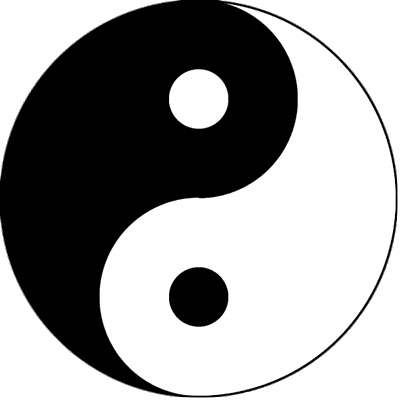The 29th Hexagram of the I Ching: The Kǎn (Water) Hexagram
Symbolism of Kǎn Hexagram: Representation of Water
Kǎn symbolizes water in the I Ching, represented by the hexagram “☵.” The creation of this symbol stems from the ancient Chinese observation of the powerful, forceful currents in rivers. The strong, central flow of water was likened to an arrow, shooting forward, while the waves and ripples on both sides moved either quickly or slowly. The single line (“一”) was used to represent the central flow, and the expanding ripples or tributaries. Combined, these elements formed the hexagram “☵,” symbolizing water.

Interpretation from “Duan Yi Tian Ji”
The Kǎn hexagram is represented by two Kǎn trigrams, one above the other, signifying danger and difficulties. Kǎn represents traps or pitfalls, often indicating an extremely perilous situation. In such circumstances, it is important to maintain faith and confidence in order to break through.
Interpretation by Shao Yong, Song Dynasty Scholar
Shao Yong described this hexagram as a time of great difficulty and danger, with overwhelming obstacles. Caution and careful action are essential when facing such challenges.
Interpretation by Fu Peirong, Taiwanese Scholar
- Fortune: Gradual promotion; remain vigilant against potential threats.
- Financial situation: Wealth flows like water, business prospers.
- Home life: Neighbors are building; family bonds grow stronger.
- Health: Prone to conditions like diarrhea, but should pray sincerely.
Traditional Interpretation
This hexagram is made by stacking two Kǎn trigrams (Kǎn below and Kǎn above). Kǎn represents water and danger, and two Kǎn trigrams stacked together indicate heightened risks and challenges. One strong yang line is trapped between two weak yin lines. However, the yin is weak, and the yang is strong, symbolizing the need for sincerity and confidence to break through the obstacles.
Despite the overwhelming dangers, these challenges reveal the potential for personal brilliance when overcome.
Great Symbol: Two waters overlap, representing danger. Moving forward is risky, but retreating is also dangerous. Both options present difficulties, leaving one in a state of indecision.
Fortune: There are many crises and challenges ahead. It is crucial to maintain composure, keep a clear mind, and avoid unnecessary conflicts.
Career: One faces numerous, difficult obstacles. Risks abound, and it is not advisable to act recklessly. However, one should not resign to fate either. It is important to approach the situation with a proactive attitude, create favorable conditions, and transform the circumstances to reduce danger. With sincerity, confidence, and wisdom, one can overcome these difficulties.
Business: The situation is highly unfavorable, even potentially leading to bankruptcy. However, one should remain calm and grounded, keeping a clear head in perilous circumstances. Avoid rash decisions, prioritize self-preservation, and carefully observe the situation before acting. Seize the right moment to escape danger.
Reputation: This hexagram suggests a period of being misunderstood and underappreciated. It is crucial not to give up in despair. Stay true to your principles, remain calm, and progress steadily. Over time, others will recognize your worth.
Romantic Relationships: Relationships may face challenges and setbacks. Analyze the reasons for the difficulties carefully and strive to improve yourself. Both parties need to support each other and navigate through the hardships together.
Decision-Making: Although the situation is unfortunate, it is a test before a change in fortune. As long as you do not lose your composure in the face of adversity, and avoid relying on luck, you can overcome the crisis. Stay calm, avoid impulsive actions, observe the situation, and the opportunity to turn the crisis into a safe resolution will come.
Philosophical Meaning of the First Line of the Kǎn Hexagram
Text of the Line:
Initial Six (初六): “Xí Kǎn, rù yú Kǎn jiào, xiōng.”
Translation: “Practicing Kǎn, falling into the Kǎn pit, misfortune.”
Interpretation of the Line Text:
“Xí Kǎn” refers to the state of being surrounded by Kǎn, symbolizing a situation of danger or adversity. “Kǎn jiào” (坎窖) refers to a small pit or deep hole, often a metaphor for a trap or a dangerous situation. “Rù yú Kǎn jiào” means falling into a pit of danger, further intensifying the perilous condition. The Initial Six (初六) is an阴 (yin) line in the lower position, representing a situation of weakness, with no support above, which leads to a loss of direction (失道), resulting in misfortune.
Thus, the line suggests that when one is in a perilous situation, without strength or support, the outcome is bad, symbolizing a fall into an insurmountable trap.
Philosophical Advice for This Line:
When encountering this line, remember:
- “A pearl at the bottom of the sea is hard to find; beware of falling into the Kǎn pit, where danger lurks.”
- “Strive to stand up by yourself, like a sapling growing with the spring breeze.”
- “Regret will follow if you’re careless; the pursuit of fleeting beauty leads to disappointment.”
- “Effort yields no reward when spring has passed, as all efforts turn to emptiness.”
Transformation of the First Line:
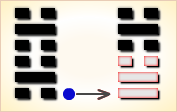
When the Initial Six (初六) line moves, it transforms into the 60th hexagram of the I Ching: Water over Marsh (水泽节). This hexagram consists of two different trigrams stacked together, Dùi (兑), symbolizing the marsh, and Kǎn (坎), symbolizing water. The marsh has water that is limited in flow—excessive water overflows beyond its bounds, suggesting that there must be balance and regulation in life. Hence, the name “节” (Jié), meaning “restraint” or “moderation.” The concept of moderation is essential for renewal in nature, stability in society, and perfection in the individual.
Philosophical Meaning of the Second Line of the Kǎn Hexagram
Text of the Line:
Nine Two (九二): “Kǎn yǒu xiǎn, qiú xiǎo dé.”
Translation: “There is danger in Kǎn; seek small gains.”
Interpretation of the Line Text:
The second line indicates that there is danger in a situation (Kǎn), and attempting to seek large gains may lead to loss. Instead, small gains or modest achievements are advisable in such circumstances.
Philosophical Advice for This Line:
When encountering this line, remember:
- “In danger, with no help, seek only small successes.”
- “Standing by the water’s edge, the ground is stable, but regret comes when we are too cautious.”
- “Dreaming of smooth sailing on the East River, but even when the water is calm, fishing remains hard.”
- “Though distant hopes for fame may come, they are not yet visible to the present leader.”
Transformation of the Second Line:
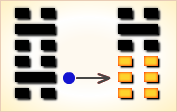
When the Nine Two (九二) line moves, it transforms into the 8th hexagram of the I Ching: Water over Earth (水地比). This hexagram consists of Kūn (坤), symbolizing the earth, and Kǎn (坎), symbolizing water. The water flows over the earth, and the earth supports the water, creating mutual dependence and support. This hexagram represents harmony, cooperation, and mutual assistance. It stresses the importance of being close, united, and selfless, allowing growth through cooperation.
Philosophical Meaning of the Third Line of the Kǎn Hexagram
Text of the Line:
Six Three (六三): “Lái zhī Kǎn Kǎn, xiǎn qiě zhěn, rù yú Kǎn jiào, wù yòng.”
Translation: “Coming and going is dangerous, fraught with risks, falling into the Kǎn pit; do not proceed.”
Interpretation of the Line Text:
This line represents a situation where danger is omnipresent, and both actions (coming and going) are fraught with peril. Falling into a pit of Kǎn means the situation is so dire that no positive outcome can result from it. It suggests that action in such conditions is ill-advised, and one should refrain from making decisions.
Philosophical Advice for This Line:
When encountering this line, remember:
- “Sailing through water brings disaster; even the car breaks down and cannot move.”
- “Stay cautious in the middle of peril; do not panic or act rashly.”
- “Do not move forward, do not approach.”
- “The flower in the rain falls easily; the moon in the waves shines bright yet is elusive.”
Transformation of the Third Line:
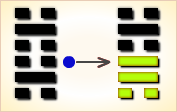
When the Six Three (六三) line moves, it transforms into the 48th hexagram of the I Ching: Water over Wind (水风井). This hexagram consists of Xùn (巽), symbolizing wind, and Kǎn (坎), symbolizing water. It signifies a well that nourishes the surrounding area. The well provides water, and the wind allows the water to circulate. It symbolizes the idea that human effort (digging a well) and natural resources (water) sustain each other, encouraging persistence and hard work.
Philosophical Meaning of the Fourth Line of the Kǎn Hexagram
Text of the Line:
Six Four (六四): “Zūn jiǔ guǐ èr, yòng fǒu, nà yuē zì yǒu, zhōng wú jiù.”
Translation: “A wine vessel, two plates of offerings, using a jar, sending the offerings through a window, ultimately no misfortune.”
Interpretation of the Line Text:
In this line, zūn (樽) refers to a wine vessel, and guǐ (簋) refers to an ancient ritual vessel used to hold food. Fǒu (缶) refers to a small jar, typically used for wine, and yǒu (牖) refers to a window. The line metaphorically describes a situation in which simple offerings are made, without extravagance or excess, passed through a window to avoid creating disruption. The ultimate outcome is positive, indicating that simplicity and modesty in approach lead to success without misfortune.
Philosophical Advice for This Line:
When encountering this line, remember:
- “A jar of wine and two plates of offerings—modesty brings no harm.”
- “Do not rush for high positions or excess wealth; remain grounded, and good fortune will come.”
- “A king and his ministers should maintain mutual respect and trust, and success will come without needing to ask.”
- “Do not be too quick to judge or assume; every step will reveal its meaning in due time.”
- “Even a long fishing rod can bring in gold when you are patient and steady.”
Transformation of the Fourth Line:

When the Six Four (六四) line moves, it transforms into the 47th hexagram of the I Ching: Marsh over Water (泽水困). This hexagram consists of Kǎn (坎), symbolizing water, and Dùi (兑), symbolizing the marsh. The hexagram reflects a situation of being trapped or facing a difficult situation where one’s talents are not fully expressed. However, by adhering to the right path and maintaining one’s integrity, success can be achieved, and one can escape the dilemma.
Philosophical Meaning of the Fifth Line of the Kǎn Hexagram
Text of the Line:
Nine Five (九五): “Kǎn bù yíng, zhǐ jì píng, wú jiù.”
Translation: “Kǎn is not full, it has reached an even level; there is no misfortune.”
Interpretation of the Line Text:
The phrase yíng (盈) refers to fullness, and bù yíng (不盈) means that the Kǎn situation is not yet filled to the point of overflowing. It has reached a balanced state, suggesting that the dangers are not overwhelming, and there is no misfortune in this phase.
Philosophical Advice for This Line:
When encountering this line, remember:
- “When things are full but not overflowing, no harm will come.”
- “When the sail sets on a distant journey, it is swift, but it still needs guidance.”
- “A magpie singing on the roof is a joyful sign, but the dream of success may still elude you.”
- “Even without immediate success, stay cautious and mindful of right and wrong.”
Transformation of the Fifth Line:

When the Nine Five (九五) line moves, it transforms into the 7th hexagram of the I Ching: Earth over Water (地水师). This hexagram consists of Kūn (坤), symbolizing earth, and Kǎn (坎), symbolizing water. The “shī” (师) in this hexagram refers to military forces, representing the idea of order and strategy. The hexagram suggests that, although warfare or conflict may be dangerous, success can be achieved by aligning with the natural flow of things and using wisdom in decision-making, turning potential harm into benefit.
Philosophical Meaning of the Sixth Line of the Kǎn Hexagram
Text of the Line:
Above Six (上六): “Xì yòng huī wěi, zhì yú cóng jí, sān suì bù dé, xiōng.”
Translation: “Tied with a cord of three strands, placed in the thicket, unable to escape for three years, misfortune.”
Interpretation of the Line Text:
The phrase xì (系) refers to being tied or bound, and huī wěi (徽纆) refers to a three-strand rope. Cóng jí (丛棘) refers to a thicket or a dangerous place, often symbolizing imprisonment. This line represents a situation of being trapped and unable to escape, where even with effort, one cannot free themselves from their circumstances for a prolonged period of time. It symbolizes a situation that leads to misfortune and long-term suffering.
Philosophical Advice for This Line:
When encountering this line, remember:
- “Three years trapped with no way out brings deep concern. Wait patiently and avoid rash actions.”
- “Sometimes, it is necessary to walk alone on a difficult path, but the right moment will come.”
- “Doubt and confusion will cloud your judgment, and joy will quickly turn into sorrow.”
- “Like fallen flowers scattered on the ground, no one will come to clean up the mess; you must stand alone in the autumn wind.”
Transformation of the Sixth Line:
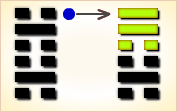
When the Above Six (上六) line moves, it transforms into the 59th hexagram of the I Ching: Wind over Water (风水涣). This hexagram consists of Xùn (巽), symbolizing wind, and Kǎn (坎), symbolizing water. The wind stirs the water, creating movement and dispersion. Huàn (涣), meaning to scatter, symbolizes a situation where the energy or organization of something is dissipating. It suggests that a scattered situation must be addressed through active measures and wisdom to restore order and avoid further deterioration, transforming a crisis into safety.
